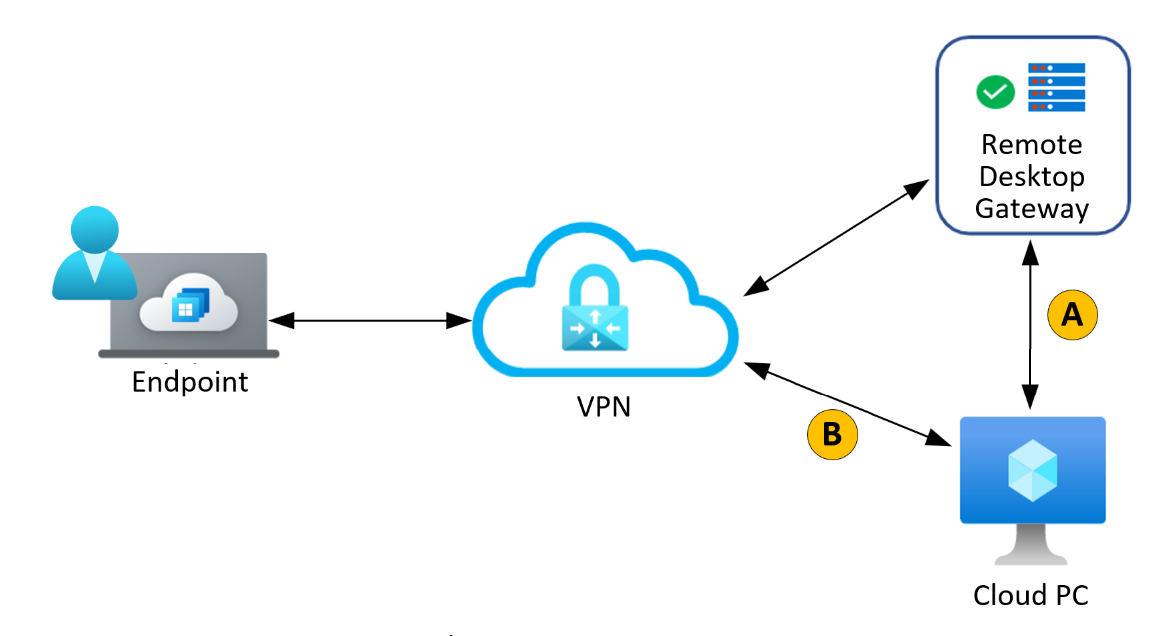Utiliser RDP Shortpath pour les réseaux privés avec Windows 365
Vous pouvez utiliser Remote Desktop Protocol (RDP) Shortpath pour les réseaux privés avec vos PC cloud Windows 365.
Configuration requise
Pour utiliser RDP Shortpath pour les réseaux privés avec Windows 365, vous devez respecter les conditions suivantes :
- PC cloud approvisionnés sur le réseau privé du client. Les réseaux privés sont pris en charge avec les connexions réseau Azure. Les réseaux hébergés par Microsoft ne sont pas pris en charge.
- Hôte de la session (Cloud PC)
- Activez un écouteur UDP sur le port UDP 3390.
- Connectivité directe entre le client et l’hôte de session. Cela signifie que le client peut se connecter directement à l’hôte de session sur le port 3390 (par défaut) :
- Sans être bloqué par les pare-feu (y compris le Pare-feu Windows) ou le groupe de sécurité réseau.
- Utilisation d’un réseau managé tel que :
- Peering privé ExpressRoute.
- Site à site ou VPN point à site (IPsec), comme Azure passerelle VPN.
Si vous utilisez d’autres types de VPN pour vous connecter à Azure, un VPN udp offre de meilleures performances. Bien que la plupart des solutions VPN basées sur TCP prennent en charge udp imbriqué, elles ajoutent une surcharge héritée du contrôle de congestion TCP, ce qui ralentit les performances RDP.
Activer RDP Shortpath pour les réseaux privés
Pour configurer et activer RDP Shortpath pour les réseaux privés, visitez la page de documentation Azure Virtual Desktop et suivez les instructions.
Avantages de RDP Shortpath
La connectivité par défaut à un PC Windows 365 Cloud se fait par une connexion TCP qui traverse une passerelle en utilisant le transport de connexion inverse. Le transport inverse signifie qu'il n'est pas nécessaire d'avoir une connectivité entrante vers l'hôte de session (PC en cloud) pour connecter le trafic RDP.
RDP Shortpath s'appuie sur la connexion TCP et fournit, lorsque cela est possible, une autre connexion directe entre le client Remote Desktop et le PC Windows 365 Cloud. Cette connexion utilise UDP comme protocole de transport sous-jacent. Cette connexion UDP est une connexion directe sur le réseau géré par le client.

A. Après l’authentification, une connexion inversée WebSocket à l’aide de TCP est établie sur le port 443.
B. UDP sur un réseau privé à l’aide du port 3390. Si la connexion UDP est établie avec succès, la session RDP bascule vers ce chemin.
Pour plus d'informations sur les avantages de RDP Shortpath, voir Principaux avantages.
Processus de connexion RDP Shortpath
Lorsque vous utilisez RDP Shortpath, la connexion avec le PC Cloud se déroule comme suit :
- La connexion RDP établit une connexion basée sur TCP en utilisant le transport de connexion inverse via la passerelle (de la même manière que pour la connectivité sans RDP Shortpath).
- L’hôte de session envoie la liste de ses adresses IPv4 et IPv6 au client.
- Le client démarre le thread d’arrière-plan pour établir un transport UDP parallèle directement vers l’une des adresses IP de l’hôte de session.
- Pendant que le client vérifie les adresses IP fournies, il continue d’établir la connexion initiale sur le transport de connexion inverse pour s’assurer qu’il n’y a pas de retard dans la connexion utilisateur.
- Si le client dispose d’une connexion directe à l’hôte de session, il établit une connexion sécurisée à l’aide du protocole TLS sur udp fiable.
- Après avoir établi le transport RDP Shortpath, tous les canaux virtuels dynamiques (DCS), y compris les graphiques distants, les entrées et la redirection des appareils, sont déplacés vers le nouveau transport. Toutefois, si un pare-feu ou une topologie de réseau empêche le client d’établir une connectivité UDP directe, RDP continue avec un transport de connexion inverse.
Étapes suivantes
Pour plus d’informations, consultez RDP Shortpath pour Azure Virtual Desktop.